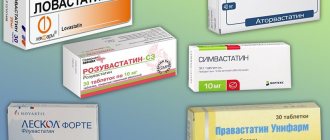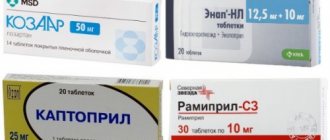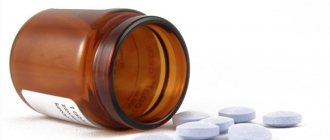Aprovask, 5 mg+300 mg, film-coated tablets, 28 pcs.
Frequency of adverse events/reactions (AEs/ARs) reported in clinical trials of the fixed-dose combination of irbesartan and amlodipine ( I-ADD
,
I-COMBINE
and
I-COMBO
), in clinical studies on the use of irbesartan and during its post-marketing use, as well as in clinical studies on the use of amlodipine, was determined according to the WHO classification as follows: very often (≥10%); often (≥1 and <10%); uncommon (≥0.1 and <1%); rare (≥0.01 and <0.1%); very rare (<0.01%), frequency unknown - the frequency of occurrence of AEs/ARs cannot be estimated from the available data.
The frequency of HP reported during post-marketing use of the drug was defined as frequency unknown because information about these HPs came from spontaneous reports, without indicating the number of patients taking the drug.
In clinical studies comparing fixed-dose combinations of amlodipine + irbesartan with irbesartan or amlodipine monotherapy, the types and incidence of treatment-emergent AEs possibly related to the study treatment were similar to those observed in prior clinical studies or in post-marketing reports with irbesartan monotherapy and amlodipine.
The most commonly reported adverse event was peripheral edema, primarily related to amlodipine.
AEs observed during treatment and possibly related to the study drug in clinical studies of amlodipine/irbesartan (I-ADD, I-COMBINE and I-COMBO)
General disorders and disorders at the injection site:
often - peripheral edema, edema; infrequently - asthenia.
Hearing and labyrinth disorders:
infrequently - vertigo.
From the heart:
often - a feeling of palpitations; infrequently - sinus bradycardia.
From the nervous system:
often - dizziness, headache, drowsiness; infrequently - paresthesia.
From the genital organs and breast:
infrequently - erectile dysfunction.
From the respiratory system, chest and mediastinal organs:
infrequently - cough.
From the side of blood vessels:
often - orthostatic hypotension; infrequently - excessive decrease in blood pressure.
From the gastrointestinal tract:
often - swelling of the gums; infrequently - nausea, pain in the upper abdomen, constipation.
From the kidneys and urinary tract:
often - proteinuria; infrequently - azotemia, hypercreatinemia.
Metabolism and nutrition:
infrequently - hyperkalemia.
From the musculoskeletal and connective tissue side:
infrequently - joint stiffness, arthralgia, myalgia.
AEs observed with irbesartan in clinical studies (including the I-ADD, I-COMBINE and I-COMBO clinical studies) and during its post-marketing use
From the immune system:
frequency unknown - hypersensitivity reactions (allergic reactions).
Metabolism and nutrition:
frequency unknown - hyperkalemia.
Hearing and labyrinth disorders:
often - vertigo; frequency unknown - tinnitus.
From the nervous system:
often - dizziness, headache*; infrequently - orthostatic dizziness.
*Headache incidence in I-ADD
,
I-COMBINE
and
I-COMBO
was rated as “uncommon”.
From the heart:
infrequently - tachycardia.
For the skin and subcutaneous tissues:
frequency unknown - leukocytoclastic vasculitis.
From the respiratory system, chest and mediastinal organs:
infrequently - cough.
From the gastrointestinal tract:
often - nausea/vomiting, pain in the upper abdomen, tongue disorders, including dysgeusia (taste distortion), glossodynia (burning sensation and soreness in the tongue), glossitis (inflammation of the tongue); infrequently - diarrhea, dyspepsia, heartburn.
From the liver and biliary tract:
frequency unknown - jaundice, increased liver function tests, hepatitis.
For the skin and subcutaneous tissues:
infrequently - alopecia; frequency unknown - angioedema, urticaria.
From the musculoskeletal system and connective tissue:
frequency unknown - myalgia.
From the kidneys and urinary tract:
frequency unknown - impaired renal function, including isolated cases of renal failure in patients with risk factors for its development.
From the genital organs and breast:
infrequently - erectile dysfunction.
General disorders and disorders at the injection site:
often - increased fatigue*, swelling; uncommon - chest pain; frequency unknown - asthenia.
* Incidence of fatigue in I-ADD
,
I-COMBINE
and
I-COMBO
were rated as uncommon.
Injuries, intoxications and complications of manipulations:
frequency unknown - falls.
Adverse events observed with amlodipine in clinical studies (including the I-ADD, I-COMBINE and I-COMBO clinical studies)
From the blood and lymphatic system:
very rarely - thrombocytopenia.
From the immune system:
very rarely - allergic reactions.
Metabolism and nutrition:
very rarely - hyperglycemia.
Mental disorders:
infrequently - insomnia, mood lability.
From the nervous system:
often - dizziness, headache*, drowsiness; infrequently - hypoesthesia, paresthesia, tremor, taste disturbances, syncope; very rarely - peripheral neuropathy.
*Headache incidence in I-ADD
,
I-COMBINE
and
I-SOMBO
were rated as “uncommon.”
From the side of the organ of vision:
infrequently - visual disturbances.
Hearing and labyrinth disorders:
infrequently - ringing in the ears, vertigo.
From the heart:
often - a feeling of palpitations; very rarely - myocardial infarction, cardiac arrhythmias, ventricular tachycardia and atrial fibrillation (atrial fibrillation).
From the side of blood vessels:
often - a rush of blood to the skin with a feeling of heat, redness of the skin*; infrequently - excessive decrease in blood pressure; very rarely - vasculitis.
* Incidence of skin redness in I-ADD
,
I-COMBINE
and
I-COMBO
were rated as uncommon.
From the respiratory system, chest and mediastinal organs:
often - cough; infrequently - shortness of breath, rhinitis; very rarely - coughing.
From the digestive system:
often - nausea, abdominal pain, glossodynia, glossitis; infrequently - dyspepsia, vomiting, change in the rhythm of bowel movements, dryness of the mucous membranes of the oral cavity; very rarely - pancreatitis, gastritis, gum hyperplasia.
From the liver and biliary tract:
very rarely - hepatitis, jaundice and increased activity of liver enzymes (mainly associated with cholestasis).
For the skin and subcutaneous tissues:
often - contact dermatitis; uncommon - skin rash, itching, purpura, increased sweating, changes in skin pigmentation (appearance of discolored areas of the skin), alopecia; very rarely - angioedema, erythema multiforme, urticaria.
From the musculoskeletal and connective tissue side:
uncommon - arthralgia, muscle cramps, myalgia, back pain.
From the kidneys and urinary tract:
infrequently - increased frequency of urination, painful urge to urinate, nocturia.
From the genital organs and breast:
infrequently - impotence, gynecomastia.
General disorders and disorders at the injection site:
often - increased fatigue, edema*, peripheral edema; infrequently - chest pain, asthenia, feeling of malaise, pain; rarely - swelling of the face.
*Based on I-ADD
,
I-COMBINE
and
I-COMBO
incidence of edema: uncommon.
Laboratory and instrumental data:
infrequently - weight gain, weight loss.
Aprovask tab p/pl/o 5mg+150mg N28 (Sanofi)
Combined antihypertensive drug. The pharmacodynamic properties of each of the active substances included in the drug Aprovac®, irbesartan and amlodipine, contribute to their additive antihypertensive effect when used in combination compared to that when each of these drugs is used separately. Both angiotensin II receptor antagonists (ARA II) and slow calcium channel blockers reduce blood pressure by reducing peripheral vascular resistance, blocking the entry of calcium into the cell and reducing the vasoconstrictor effect caused by angiotensin II are complementary mechanisms. Irbesartan Irbesartan is a selective, highly active APA II (subtype-AT1). Angiotensin II is an important component of the RAAS, involved in the pathophysiology of the development of arterial hypertension and in the homeostasis of sodium ions. To exert its effect, irbesartan does not require metabolic activation. Irbesartan blocks the strong vasoconstrictor and aldosterone-secreting effects of angiotensin II due to selective antagonism of angiotensin II receptors (subtype AT1), located in the cells of vascular smooth muscle and the adrenal cortex. Irbesartan does not have agonistic activity towards AT1 receptors. Its affinity for AT1 receptors is 8500 times greater than for AT2 receptors (receptors that have not been shown to be associated with maintaining equilibrium [homeostasis] of the cardiovascular system). Irbesartan does not inhibit RAAS enzymes (such as renin, ACE), and also does not affect other hormonal receptors or ion channels in the cardiovascular system involved in the regulation of blood pressure and sodium ion homeostasis. Blockade of AT1 receptors by irbesartan breaks the feedback loop in the renin-angiotensin system, increasing plasma concentrations of renin and angiotensin II. When using irbesartan, the plasma concentration of aldosterone decreases, however, when using the drug in recommended doses, there are no significant changes in the potassium content in the blood serum (the average increase in the potassium content in the blood serum is less than 0.1 mEq/L). Irbesartan does not have a significant effect on the concentrations of triglycerides, cholesterol or glucose in the blood serum. Irbesartan does not affect serum uric acid concentrations or renal excretion of uric acid. The antihypertensive effect of irbesartan develops after the first dose and becomes significant within 1-2 weeks of treatment with the maximum effect occurring after 4-6 weeks. In long-term observational studies, the effect of irbesartan persisted for more than 1 year. A single dose of irbesartan in doses up to 900 mg/day caused a dose-dependent decrease in blood pressure. A single dose of irbesartan in doses of 150-300 mg/day led to a greater decrease in systolic (SBP)/diastolic (DBP) blood pressure (24 hours after dosing) in the supine or sitting position (on average by 8-13/5-8 mm Hg) than when taking placebo. The effect of the drug 24 hours after dosing was 60-70% of the corresponding maximum reduction in DBP and SBP. Optimal effectiveness in reducing blood pressure within 24 hours is achieved with a single dose of the drug per day. Blood pressure decreases to approximately the same extent in the standing and lying position. The orthostatic effect is rare and, as with the use of ACE inhibitors, its occurrence can be expected in patients with hyponatremia or hypovolemia. The antihypertensive effect of irbesartan and thiazide diuretics is additive. In patients who fail to achieve target blood pressure values with irbesartan monotherapy, adding small doses of hydrochlorothiazide (12.5 mg) to irbesartan once a day leads to an additional (compared to the effect of adding placebo) reduction in SBP/DBP determined after 24 hours after taking them, by 7-10/3-6 mm Hg. Art., respectively. Age and gender do not affect the effectiveness of irbesartan. As in the case of treatment with other drugs that affect the RAAS, patients of the Negroid race have a weaker antihypertensive effect with irbesartan monotherapy. When irbesartan is taken with small doses of hydrochlorothiazide (for example, 12.5 mg/day), the antihypertensive effect in black patients approaches that in Caucasian patients. After discontinuation of irbesartan, blood pressure gradually returns to its original level. No withdrawal syndrome was observed upon discontinuation of irbesartan. Amlodipine Amlodipine is a slow calcium channel blocker from the group of dihydropyridine derivatives, which inhibits the transmembrane entry of calcium ions into myocardial cells and vascular smooth muscle. The mechanism of the antihypertensive effect of amlodipine is associated with a direct relaxing effect on vascular smooth muscle. The exact mechanism by which amlodipine reduces the frequency and severity of angina attacks is not fully established, but amlodipine reduces myocardial ischemia due to the following two effects. 1) Amlodipine expands peripheral arterioles and due to this reduces the peripheral vascular resistance, the so-called afterload. Because Heart rate practically does not increase when taking amlodipine; this decrease in the load on the heart muscle reduces the energy consumption of the myocardium and its oxygen demand. 2) The mechanism of the antianginal action of amlodipine also appears to be associated with the expansion of the main coronary arteries and coronary arterioles, as in areas of the myocardium with normal blood flow and in ischemic areas of the myocardium. This expansion of the coronary vessels increases the delivery of oxygen to the myocardium in patients with spasm of the coronary arteries (with Prinzmetal's angina or variant angina). In patients with arterial hypertension, taking amlodipine 1 time per day provides a clinically significant reduction in blood pressure in the supine and standing position for 24 hours. Due to the slow onset of its action, amlodipine is not intended for the relief of hypertensive crises. In patients with angina pectoris, a single daily dose of amlodipine during an exercise test increases the total time of physical activity, the time before the onset of an angina attack and the time before the appearance of ST segment depression on the ECG 1 mm deep. In addition, taking the drug reduces the daily number of angina attacks and the daily need for taking nitroglycerin tablets. When taking amlodipine, no undesirable metabolic effects or changes in blood lipid concentrations were observed. Amlodipine can be prescribed to patients with bronchial asthma, diabetes mellitus and gout. Clinical evidence of the effectiveness of the fixed-dose combination of irbesartan and amlodipine was obtained from two multicenter, prospective, open-label, parallel-group studies with blinded assessment of efficacy indicators: the I-ADD and I-COMBINE studies. The results of both studies demonstrated significantly greater efficacy of fixed-dose combinations of irbesartan and amlodipine compared with amlodipine monotherapy or irbesartan monotherapy.
Aprovask
The incidence of adverse events/reactions (AEs/ARs) reported in clinical studies of the fixed-dose combination of irbesartan and amlodipine, in clinical studies of irbesartan and during its post-marketing use, as well as in clinical studies of amlodipine, was determined by World Health Organization (WHO) classifications as follows: very common > 10%; often > 1% and 0.1% and 0.01% and
The frequency of adverse events reported during post-marketing use of the drug was defined as 'frequency unknown', since information about these adverse events came from spontaneous reports, without indicating the number of patients taking the drug.
In clinical studies comparing fixed-dose combinations of irbesartan/amlodipine with irbesartan or amlodipine monotherapy, the types and incidence of treatment-emergent adverse events possibly related to the study treatment were similar to those observed in previous clinical studies or in post-marketing reports with monotherapy with irbesartan and amlodipine. The most commonly reported adverse event was peripheral edema, primarily related to amlodipine.
Adverse events observed during treatment and possibly related to the study drug in clinical studies of irbesartan/amlodipine:
General disorders and administration site disorders: Common: peripheral edema, edema; Uncommon: asthenia.
Hearing and labyrinthine disorders: Uncommon: vertigo.
Cardiac disorders: Common: palpitations; Uncommon: sinus bradycardia.
Nervous system disorders: Common: dizziness, headache, drowsiness.
Genital and breast disorders: uncommon: erectile dysfunction.
Respiratory, thoracic and mediastinal disorders: Uncommon: cough.
Vascular disorders: Common: orthostatic hypotension. Uncommon: excessive decrease in blood pressure.
Gastrointestinal disorders: Common: swelling of the gums; uncommon: nausea, pain in the upper abdomen, constipation.
Renal and urinary tract disorders: Common: proteinuria; Uncommon: azotemia, hypercreatinemia.
Metabolic and nutritional disorders: uncommon: hyperkalemia.
Musculoskeletal and connective tissue disorders: Uncommon: joint stiffness,
arthralgia, myalgia.
Adverse events observed with the use of irbesartan in clinical trials and during its post-marketing use.
Immune system disorders: Frequency unknown: hypersensitivity reactions (allergic reactions).
Metabolic and nutritional disorders: Frequency unknown: hyperkalemia.
Hearing and labyrinthine disorders: Common: vertigo; Frequency unknown: tinnitus.
Nervous system disorders: often: dizziness, headache; Uncommon: orthostatic dizziness.
Cardiac disorders: Uncommon: tachycardia.
Skin and subcutaneous tissue disorders: Not known: leukocytoclastic vasculitis.
Respiratory, thoracic and mediastinal disorders: Uncommon: cough.
Gastrointestinal disorders: Common: nausea/vomiting, pain in the upper part
abdomen, tongue disorders, including dysgeusia (taste distortion), glossodynia (burning sensation and soreness in the tongue), glossitis (inflammation of the tongue). Uncommon: diarrhea, dyspepsia, heartburn.
Liver and biliary tract disorders: Frequency unknown: jaundice, increased liver function tests, hepatitis.
Skin and subcutaneous tissue disorders: Uncommon: alopecia. Frequency unknown: angioedema
swelling, urticaria.
Musculoskeletal and connective tissue disorders: Not known: myalgia.
Renal and urinary tract disorders: Not known: renal dysfunction, including isolated cases of renal failure in patients with risk factors for its development.
Genital and breast disorders: Uncommon: erectile dysfunction.
General disorders and disorders at the injection site: Often: increased fatigue, swelling. Uncommon: chest pain. Frequency unknown: asthenia.
Injuries, intoxications and complications of manipulations: Uncommon: falls.
Adverse events observed with the use of amlodipine in clinical studies:
Blood and lymphatic system disorders: Very rare: thrombocytopenia.
Immune system disorders: Very rare: allergic reactions.
Metabolic and nutritional disorders: Very rare: hyperglycemia.
Mental disorders: Uncommon: insomnia, mood lability.
Nervous system disorders: Common: dizziness, headache, drowsiness. Uncommon: hypoesthesia, paresthesia, tremor, taste disturbances, syncope. Very rare: peripheral neuropathy.
Visual disorders: Uncommon: visual disturbances.
Hearing and labyrinthine disorders: Uncommon: tinnitus, vertigo.
Cardiac disorders: Common: palpitations. Very rare: myocardial infarction, cardiac arrhythmias, ventricular tachycardia and atrial fibrillation (atrial fibrillation).
Vascular disorders Often: “flushes” of blood to the skin with a feeling of heat, redness of the skin. Uncommon: excessive decrease in blood pressure. Very rare: vasculitis.
Respiratory system disorders. organs of the chest and mediastinum: Often: cough. Uncommon: shortness of breath, rhinitis. Very rare: coughing.
Digestive system disorders: Common: nausea, abdominal pain, glossodynia, glossitis. Uncommon: dyspepsia, vomiting, change in bowel habits, dry mouth. Very rare: pancreatitis, gastritis, gingival hyperplasia.
Liver and biliary disorders: Very rare: hepatitis, jaundice and increased activity of liver enzymes (mainly associated with cholestasis).
Skin and subcutaneous tissue disorders: Common: contact dermatitis. Uncommon: skin rash, itching, purpura, increased sweating, changes in skin pigmentation (appearance of discolored areas of the skin), alopecia. Very rare: angioedema, erythema multiforme, urticaria.
Musculoskeletal and connective tissue disorders: Uncommon: arthralgia, muscle cramps, myalgia. back pain.
Renal and urinary tract disorders: Uncommon: increased frequency of urination, painful urge to urinate, nocturia.
Genital and breast disorders: Uncommon: impotence, gynecomastia.
General disorders and administration site disorders: Common: fatigue, swelling, peripheral edema. Uncommon: chest pain, asthenia, feeling unwell, pain. Rarely: swelling of the face. Laboratory and instrumental data: Uncommon: weight gain, weight loss.
Overdose
When adults take irbesartan in doses up to 900 mg per day, no toxicity has been established.
Available data for amlodipine suggest that severe overdose may lead to significant peripheral vasodilation and possibly the development of reflex tachycardia. The development of a pronounced and prolonged excessive decrease in blood pressure, up to the development of shock with a fatal outcome, has been reported.
The patient should be under close medical supervision. Treatment should be symptomatic and support the basic vital functions of the body. Suggested measures for overdose include gastric lavage. Taking activated carbon and hemodialysis are ineffective.
If a very large overdose has occurred, active cardiac and respiratory monitoring should be initiated. Frequent measurement of blood pressure and active maintenance of cardiovascular activity, including elevating the limbs, are necessary. The volume of circulating blood and urine output should be monitored. It may be necessary to administer vasoconstrictor drugs to restore vascular tone and blood pressure (provided there are no contraindications to their administration). Intravenous calcium gluconate may be helpful in reversing the effects of calcium channel blockade.


